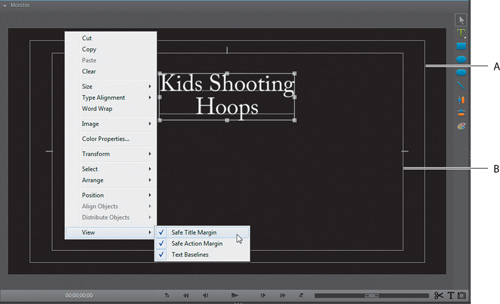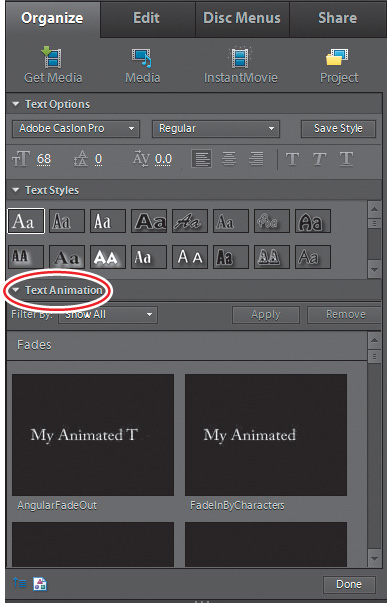Chapter 8. Titles and Credits
In this lesson, you’ll learn how to create original titles and rolling credits for a movie about some kids shooting hoops. You’ll be adding still titles and rolling titles, placing images, and using the drawing tools in the Monitor panel. Specifically, you’ll learn how to do the following:
• Add and stylize text
• Superimpose titles and graphics over video
• Create and customize rolling titles
• Use title templates
![]()
This lesson will take approximately two hours.
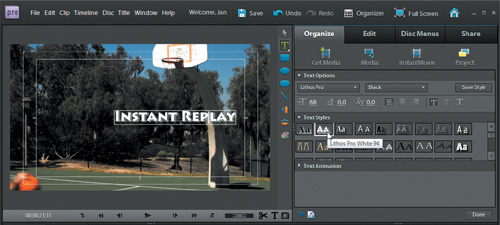
Creating an overlay title in Adobe Premiere Elements.
Working with Titles and Title-editing Mode
Within Adobe Premiere Elements, you can create custom graphics and titles. When you add a title over one of your video clips, it’s also added to your Project view as a new clip. As such, it’s treated much like any other clip in your project. It can be edited, moved, deleted, and have transitions and effects applied to it.
Premiere Elements allows you to create original titles using text, drawing tools, and imported graphics. However, to help you quickly and easily add high-quality titles to your project, Premiere Elements also provides a number of templates based on common themes such as Sports, Travel, and Weddings.
Getting Started
To begin, you’ll launch Premiere Elements and open the Lesson08 project file. Then you’ll review a final version of the project you’ll be creating.
- Before you begin, make sure that you have correctly copied the Lesson08 folder from the DVD in the back of this book onto your computer’s hard disk. See “Copying the Classroom in a Book Files” in the Getting Started section at the beginning of this book.
- Launch Premiere Elements and click the Open Project button in the Welcome screen. If necessary, click Open in the menu that appears. If Premiere Elements is already open, choose File > Open Project.
- Navigate to your Lesson08 folder and select the project file Lesson08_Start_Win.prel (Windows) or Lesson08_Start_Mac.prel (Mac OS). Click the Open button to open your project. If a dialog appears asking for the location of rendered files, click the Skip Previews button. The Premiere Elements work area appears with the Edit workspace selected in the Tasks panel.
- The project file opens in Properties view and the Media, Monitor, and My Project panels in view. Choose Window > Restore Workspace to ensure that you start the lesson with the default panel layout.
Viewing the Completed Movie Before You Start
To see what you’ll be creating as your first project in this lesson, you can play the completed movie.
- In the Organize tab of the Tasks panel, click the Project button (
 ). In Project view, locate the file Lesson08_Movie.mov, and then double-click it to open the video into the Preview window.
). In Project view, locate the file Lesson08_Movie.mov, and then double-click it to open the video into the Preview window. - In the Preview window, click the Play button (
 ) to watch the video of some kids shooting hoops, which you’ll continue to build in this lesson.
) to watch the video of some kids shooting hoops, which you’ll continue to build in this lesson. - After watching the complete movie, close the Preview window by clicking the Close button (
 ) in the upper-right corner of the window.
) in the upper-right corner of the window.
Creating a Simple Title
You can add titles to your movie—whether simple still titles, advanced titles with added graphics, or styled text scrolling across the screen horizontally or vertically—directly in the Monitor panel of Premiere Elements. To begin, you’ll create a basic still title. Working with the hoops project, you’ll add a title clip at the beginning of the movie. But first you’ll add a few seconds of black video over which you can then type the title text.
- In the Sceneline of the My Project panel, click the first clip to select it. In the upper-right corner of Project view, click the New Item button (
 ), and then choose Black Video from the menu that appears.
), and then choose Black Video from the menu that appears.
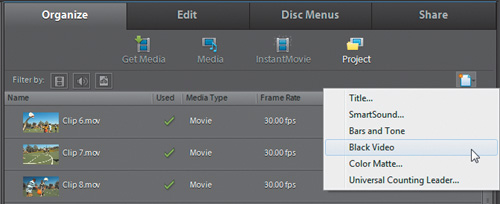
- Premiere Elements inserts a five-second black video clip after the first clip in the Sceneline. To move the black video clip to the beginning of the movie, drag it to the left of the first clip in the Sceneline.

- With the black video still selected in the Sceneline, choose Title > New Title > Default Still. Premiere Elements places the default title text over the black video in the Monitor panel and switches to title-editing mode. In the mini-timeline of the Monitor panel, notice the bluish-gray-colored clip representation for the new title clip that’s placed on top of the lavender-colored clip representation for the black video clip. Also, notice the text and drawing tools now visible on the right side of the Monitor panel, and the text options, text styles, and text animation choices accessible from Properties view.
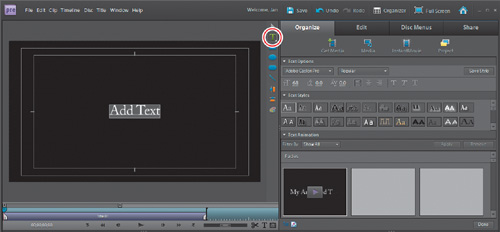
- The Horizontal Type tool should be selected by default. If it’s not, click the Type Tool button (
 ) to the right of the Monitor panel to select it now.
) to the right of the Monitor panel to select it now.

- Click in the text box and drag your pointer over the default text to select it. Type the words Kids Shooting, and then press the Enter/Return key to create a new line. Next, type the word Hoops.
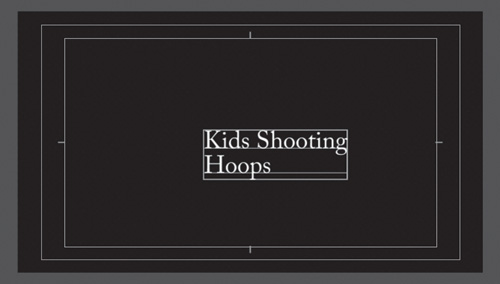
- To reposition your text, click the Selection tool (
 ) in the upper-right corner of the Monitor panel, and then click anywhere inside the text to select the text block. Drag to reposition the text so it appears centered in the upper third of your title window. Two white margins display in the title window. These are referred to as the title-safe and action-safe margins. Stay within the inner margin (title-safe) while repositioning your text. Don’t worry about the exact position for now; you’ll reposition the text later in this lesson.
) in the upper-right corner of the Monitor panel, and then click anywhere inside the text to select the text block. Drag to reposition the text so it appears centered in the upper third of your title window. Two white margins display in the title window. These are referred to as the title-safe and action-safe margins. Stay within the inner margin (title-safe) while repositioning your text. Don’t worry about the exact position for now; you’ll reposition the text later in this lesson.
Tip
You can add multiple text entries to a single title, or you can create multiple titles, each containing unique text strings.

- Choose File > Save As. In the Save As dialog, name the file Lesson08_Work.prel, and then click Save to save it in your Lesson08 folder.
Premiere Elements treats basic titles, such as the one you just created, like still image files. After you’ve created a title, an image file is automatically added to your Project view. In this case, the new title was superimposed over the black video clip at the beginning of the movie, but as you’ll see, you can also place it over any other clip in your movie. After creating and adding a title to the project, you can change text or its appearance at any time.
Modifying Text
After entering your title text, you can adjust text appearance, much like in a word processor or page layout program. In this exercise, you’ll learn how to adjust the alignment of your type as well as its style, size, and color.
Changing the Text Alignment, Style, and Size
To begin, let’s switch over to the Timeline, so you can see how Premiere Elements displays titles in that view.
- Click Timeline in the upper-left portion of the My Project panel to open Timeline view. In the Timeline, double-click the new title (Title 01), which should be on the Video 2 track.
- To center the text in its text box, use the Selection tool (
 ) to select the title text box, and then click the Center Text button (
) to select the title text box, and then click the Center Text button ( ) located under Text Options in Properties view.
) located under Text Options in Properties view.
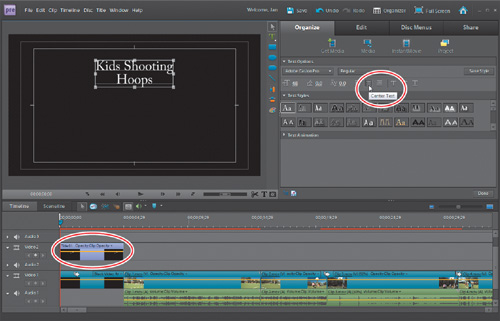
- In the Monitor panel, choose the Type tool and drag it in the text box to select the first line of text. Under Text Options in Properties view, choose ComicSans MS from the font menu and Bold from the style menu next to it. Choose another font and style if you don’t have this font on your system.
- With the first line of text still selected, to change the font size, do the following:
• Under Text Options in Properties view, place the pointer over the Size value (
 ). The pointer will change to a hand with two black arrows (
). The pointer will change to a hand with two black arrows ( ).
).• Drag to change the Size value to 75. If you have difficulties getting a precise value by dragging, click the size value once, and then type 75 into the text field.
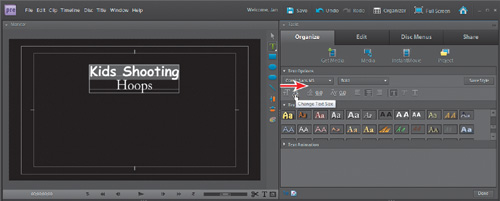
- In the Text Styles box, scroll down until you can see the Hobo Medium Gold 58 style. Then select the second line of text—the word “Hoops”—with the Type tool, and choose Hobo Medium Gold 58. This changes the text font and applies a drop shadow.
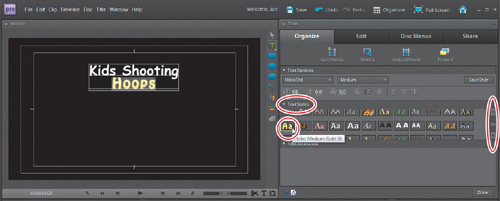
- With the word “Hoops” still selected, change the font size to 90, either by dragging the Size value to the right or by clicking the size value once and typing 90 into the text field.
- Next, you’ll spread the letters in the bottom line of text. Select “Hoops” with the Text tool, and do the following:
• Under Text Options in Properties view, locate the Kerning value next to the Kerning icon (
 ). Position the pointer over the numerical value, and it will change to a hand with two black arrows (
). Position the pointer over the numerical value, and it will change to a hand with two black arrows ( ).
).• Drag the size value to 20. If you have difficulties getting a precise value by dragging, click the size value once, and then type 20 into the text field.
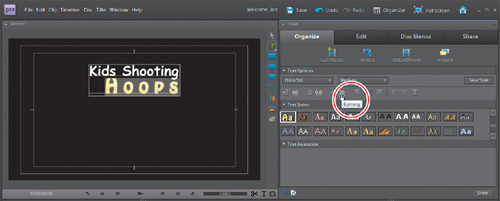
- Now you’ll increase the spacing between the two lines of text. Select both lines of text with the Text tool, and do the following:
• Under Text Options in Properties view, place the pointer over the Leading value (
 ). The pointer changes to a hand with two black arrows (
). The pointer changes to a hand with two black arrows ( ).
).• Drag the size value to 15. If you have difficulties getting a precise value by dragging, click the size value once, and then type 15 into the text field.
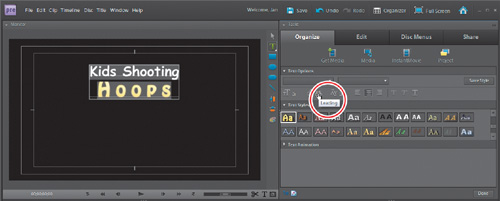
- Choose File > Save to save your work.
Centering Elements in the Monitor Panel
At this point, your title probably isn’t precisely centered horizontally within the frame. You can fix this manually, or you can let Premiere Elements do the work for you.
- Using the Selection tool, click the text box to select it.
- Choose Title > Position > Horizontal Center. Or, right-click the text box, and then choose Position > Horizontal Center. Premiere Elements centers the text box horizontally within the frame. Depending on how you positioned the box earlier in this lesson, you might see little or no change.
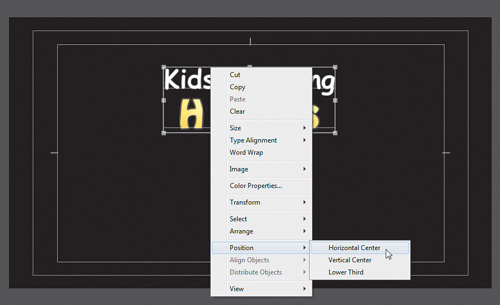
- Choose File > Save to save your work.
Changing the Color of Your Type
As you’ve seen, changing the style and size of your type is easy. You can change all text within a text box equally by first selecting the text box using the Selection tool and then applying the change. Or, you can restrict the change to portions of the text by selecting them using the Type tool. You will now change the color of the word “Hoops.”
- Select the Horizontal Type tool (
 ), and then drag over the word “Hoops” to highlight the text.
), and then drag over the word “Hoops” to highlight the text.
Next, you’ll change the gradient of the type. Note that any changes you make will apply to only the selected type.
- Click the Color Properties button (
 ) at the bottom of the tool buttons in the Monitor panel to open the Color Properties dialog. In the middle of the dialog, note the Gradient list box. The title should currently be a 4 Color Gradient. This means that the gradient comprises the four colors in the boxes at the corners of the yellow rectangle beneath the gradient list box. Experiment with the different options in the list box, and notice how they change the appearance of the text. Return to the 4 Color Gradient. Next, you’ll change the upper-left and lower-right corners of the gradient to basketball orange.
) at the bottom of the tool buttons in the Monitor panel to open the Color Properties dialog. In the middle of the dialog, note the Gradient list box. The title should currently be a 4 Color Gradient. This means that the gradient comprises the four colors in the boxes at the corners of the yellow rectangle beneath the gradient list box. Experiment with the different options in the list box, and notice how they change the appearance of the text. Return to the 4 Color Gradient. Next, you’ll change the upper-left and lower-right corners of the gradient to basketball orange.
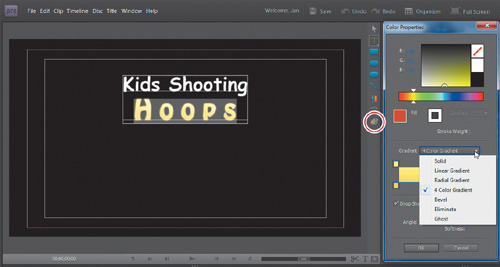
- Click the box on the top left of the gradient rectangle to select it. Then set the RGB values to R: 110, G: 24, and B: 0. Then click the box on the lower right of the gradient rectangle to select it, and set the RGB values to R: 110, G: 24, and B: 0.
- Click OK to close the Color Properties dialog. Use the Selection tool and click outside the text box in the Monitor panel to deselect the text and review your work.
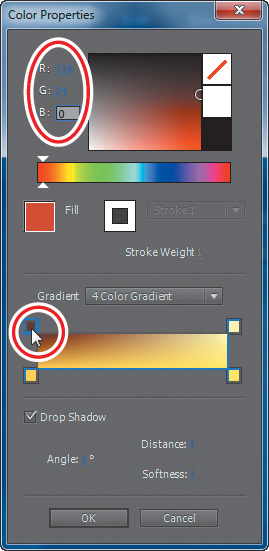
- Choose File > Save to save your work.
Adding an Image to Your Title Files
To add an extra element of depth and fun to your titles, you can import and insert images from any number of sources. For instance, you can use photos from your digital still camera as elements in your title file. In this exercise, you’ll use a still image taken from a video clip and place it in the lower half of the title image.
- With the Monitor panel still in title-editing mode, choose Title > Image > Add Image, or right-click the Monitor panel, and then choose Image > Add Image.

The file Open dialog appears. By default, the dialog may point you to the list of files in Premiere Elements Logos folder. These are the default images that were installed with the application. Feel free to use these in your other projects, whether from this book or otherwise.
Tip
If you have overlapping frames, you can change the stacking order by right-clicking on a selected frame and then using one of the Arrange commands from the context menu. To align multiple frames, select the frames you want to align, right-click, and then choose any of the Align Objects commands.
- In the Open dialog, navigate to the Lesson08 folder. Within that folder, select the file players.psd, and then click Open to import the image into your title.
- The image appears stacked in front of the text box in your title. Use the Selection tool to drag the placed image downwards, making sure that the bottom of the image stays above the action-safe area (if this were text, you’d have to make sure it was within the title-safe zone).
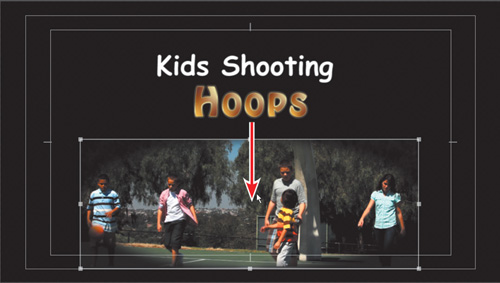
- If you’re unhappy with the size of the image you’ve inserted, drag any anchor point to resize the placed image. Hold down the Shift key while dragging to maintain the height and width proportions of the image.
- Right-click the image, and choose Position > Horizontal Center.
- Choose File > Save to save your work.
Creating Fade-in and Fade-out Effects
Any transition that you use on video clips can also be added to title clips. In this exercise, you’ll add a fade-in and fade-out effect to the title clip.
- In the Timeline view of the My Project panel, click Title 01, which should be on the Video 2 track. Click the Zoom In button to zoom into approximately the amount of detail shown in the following figure.
- At the upper left of the My Project panel, click the Properties button (
 ).
).

- In Properties view, click the twirl-down triangle next to Opacity to see the Opacity controls.
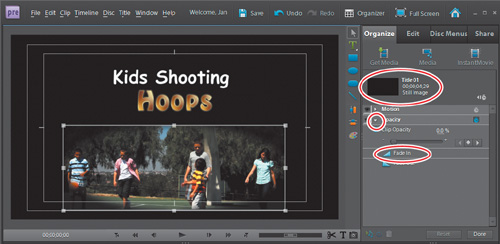
- Under Opacity in Properties view, click the Fade In button once. The title image seems to disappear from the Monitor panel. Drag the current-time indicator in the Timeline to the right to see the image fade in.
If you adjusted the default transition duration to five frames as detailed in Chapter 7, after five frames the clip’s opacity is at 100 percent and fully visible again. While five frames is an appropriate length for interscene dissolves, fade-ins should be one full second. You’ll fix that next.
- In the Timeline, drag the second keyframe in the Video 2 track to the 01;00 second mark. That extends the fade-in from five frames to one full second.

Superimposing a Title over Video Clips
Inserting titles over a black background video works well for opening titles, but Premiere Elements also lets you superimpose titles directly over video clips. Although you can add titles in both the Timeline and Sceneline, in this exercise, you’ll work in the former, adding a title to your slow-motion, instant-replay clip. Then you’ll copy the title to the start of the slide show and customize the text for that location.
- With Timeline selected in the My Project panel, press the Home key to move to the start of the movie. Then click the Page Down key three times to move to the start of Clip 3.mov; then drag the current-time indicator to around 00;00;21;11 where you can no longer see the Iris Diamond transition.
- Choose Title > New Title > Default Still. With the Text tool, select the default text and type Instant Replay.
- Drag the text to select it and click to apply the Lithos Pro White 94 text style.
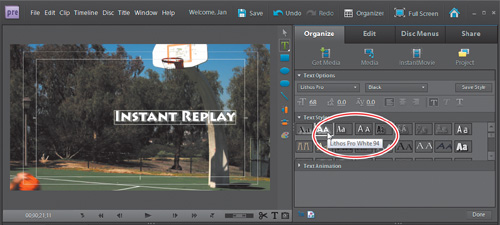
- Right-click the title text, and choose Position > Lower Third, and then choose Position > Horizontal Center. The title should be horizontally centered right above the title-safe line at the bottom of the frame.
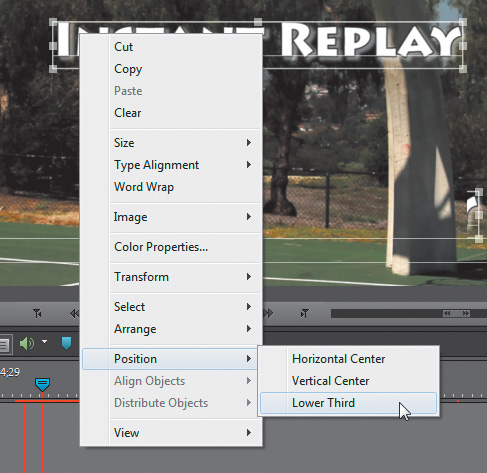
Because you chose a style with an outline and a shadow, it’s actually pretty legible against the moving background. To make it even more legible, you can add a colored rectangle behind the text, as explained in the following steps.
- Select the Rectangle tool (
 ) from the tools on the right side of the Monitor panel. The cursor changes to a crosshair. Drag to create a rectangle over the text you just created. Don’t worry about obscuring the text; in a moment, you’ll position the rectangle behind the text.
) from the tools on the right side of the Monitor panel. The cursor changes to a crosshair. Drag to create a rectangle over the text you just created. Don’t worry about obscuring the text; in a moment, you’ll position the rectangle behind the text.
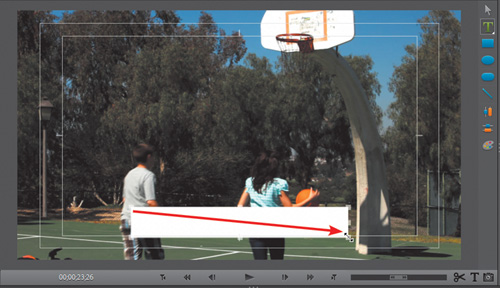
- Click the Color Properties button (
 ) at the bottom of the tool buttons in the Monitor panel to open the Color Properties dialog. Set the color to black by clicking the large black rectangle near the upper-right corner of the dialog. Click OK to apply the color to the rectangle you created and close the Color Properties dialog.
) at the bottom of the tool buttons in the Monitor panel to open the Color Properties dialog. Set the color to black by clicking the large black rectangle near the upper-right corner of the dialog. Click OK to apply the color to the rectangle you created and close the Color Properties dialog.
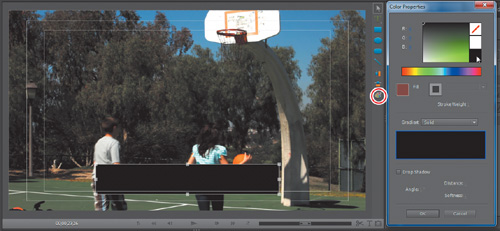
- Let’s soften the black color by making the background slightly transparent. Right-click the rectangle, and choose Transform > Opacity. The Opacity panel opens. Type 60.00 into the Opacity % field and click OK to close the panel.
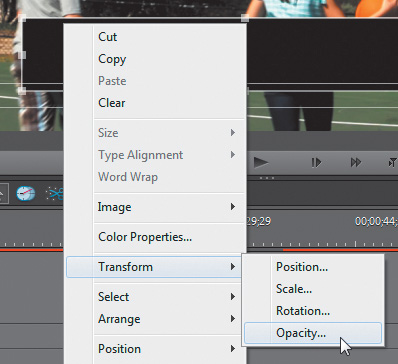
- Now you’ll shift the new rectangle behind the text. Right-click the rectangle and choose Arrange > Send to Back to place your rectangle behind your white type. The white text is now clearly visible over the rectangle. If necessary, you can edit the size of the rectangle by clicking it to make it active and then dragging any edge to a new location.

When you add multiple elements, such as text, squares, or circles to a title, you create a stacking order. The most recent items added (in this case, the rectangle) are placed at the top of the stacking order. You can control the stacking order—as you did here—using the Arrange commands from the context menu or the Title menu. To quickly add matching titles at the same position in other clips, you can use the Copy and Paste commands.
- Using the Selection tool, click to select the rectangle, and then Shift-click to select the text frame as well. Choose Edit > Copy.
- Drag the current-time indicator to around 00;01;26;21, which should be close to the start of the slide show.
- Choose Title > New Title > Default Still to switch to title-editing mode. Use the Selection tool to select the default text that was added, and then choose Edit > Clear.
- Choose Edit > Paste to add the black rectangle with the words “Instant Replay” at the same position as in the original clip. Using the Type tool, select the words “Instant Replay” and replace them by typing Slideshow.
- Use the Selection tool to select the black rectangle, and then adjust its width to the new text length by dragging the right-center anchor point to the left.
- Center the Slideshow text by clicking to select it, right-clicking, and choosing Position > Horizontal Center. Then do the same with the background rectangle.
- Review your movie, and then save your project.
Creating a Rolling Credit
The titles you have created to this point have been static, but Premiere Elements can create animated titles as well. There are two types of animated titles: rolls and crawls. A rolling credit is defined as text that moves vertically up the screen, like the end credits of a movie. A crawl is defined as text that moves horizontally across the screen, like a news ticker. In this exercise, you will create a rolling credit at the end of the project.
- Press the End key to move to the end of the project.
- Choose Title > New Title > Default Roll. Premiere Elements switches to title-editing mode and inserts a new rolling title.
- Using the Type tool, select the text Main Title at the top of the Monitor panel. In the Text Options area, click the Center Text (
 ) icon to center the text. That way, whatever you type will continue to be centered. Making sure that the Main Title text is still selected, type The End.
) icon to center the text. That way, whatever you type will continue to be centered. Making sure that the Main Title text is still selected, type The End. - Click the other text box, press Ctrl+A/Command+A to select all text, and then click the Center Text icon again to center the text. Type Starring: and press Enter/Return to move to the next line. On the next line, type Ray, press Enter/Return; type Kevin, press Enter/Return; type Paul, press Enter/Return; type Rajon, press Enter/Return; and type Semih, and press Enter/Return once more.
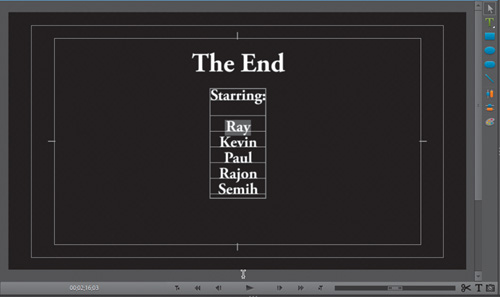
- Choose Title > Roll/Crawl Options.
- In the Roll/Crawl Options dialog, make sure Roll is selected for Title type and that both Start Off Screen and End Off Screen options are also selected. Finally, make sure that Preroll, Ease-In, Ease-Out, and Postroll values are all set to 0. Click OK to close the dialog.
When you play the clip, the text box with the credits will move—in the five-second default length of the title—from bottom to top across the monitor.
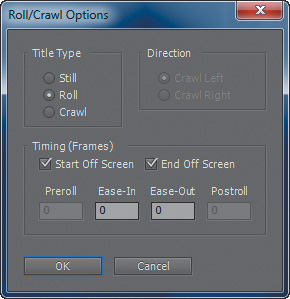
- Place your current-time indicator just before the beginning of the rolling credits. Press the spacebar to play the rolling credits clip, and then save your project.
Changing the Speed of a Rolling Title
When Premiere Elements creates a rolling title, it spreads the text evenly over the duration of the title. The only way to change the speed of a rolling title is to increase or decrease the length of the title clip. The default duration for titles is five seconds. If you want to have the text move more slowly across the screen, you need to increase the clip length.
- In the Timeline, place your pointer over the end of the Title 06 rolling title clip. When the pointer changes to a red bracket pointing to the left (
 ), drag the clip to the right. Note that as you drag there is a small context menu that shows you how much time you are adding to the clip. Add about five seconds to the length of the clip, and then release the pointer.
), drag the clip to the right. Note that as you drag there is a small context menu that shows you how much time you are adding to the clip. Add about five seconds to the length of the clip, and then release the pointer.
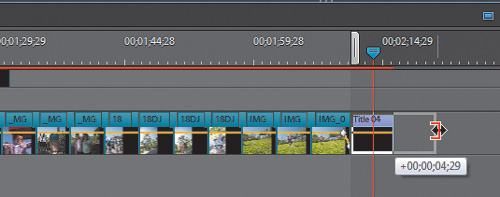
- Place your current-time indicator just before the beginning of the rolling credits. Press the spacebar to play the rolling credits clip. Notice how your titles are now moving more slowly on the monitor.
- Save your project as Lesson08_End.prel.
Using Title Templates
Creating your own titles, as you have done in the exercises in this lesson, will give you the most flexibility and options when it comes to customized titles. However, this involves performing a considerable number of steps from start to finish. To help you get started designing your titles, Premiere Elements ships with numerous templates for different types of projects, many with matching DVD templates, which creates a very polished look for your production. All you need to do is customize the text, replace an image, or do both to create a great-looking title.
- Select Titles (
 ) in the Edit tab of the Tasks panel. Choose a category of title templates from the menu on the left, and then choose a template name from the menu on the right. If necessary, scroll down to see all available templates within the chosen theme, such as rolling titles and alternative title graphics.
) in the Edit tab of the Tasks panel. Choose a category of title templates from the menu on the left, and then choose a template name from the menu on the right. If necessary, scroll down to see all available templates within the chosen theme, such as rolling titles and alternative title graphics.
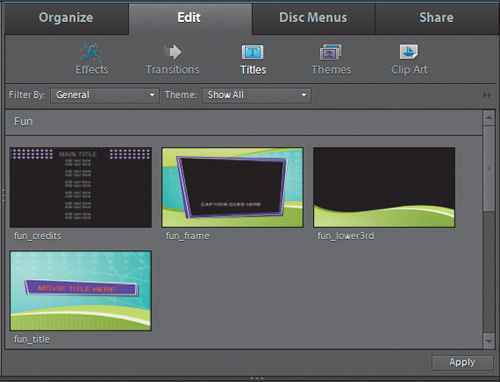
- To superimpose a title template over a video clip, select the clip in the Sceneline, and then drag the template from Titles view onto the Monitor panel. If you’re working in the Timeline, drag it to a track above the target video clip.
- Use the Type tool to select the default text and replace it with your own text. Use the Selection tool to reposition or resize text and image frames. Add or delete text and image frames as necessary.
Exploring on Your Own
Experiment with the different templates Premiere Elements provides. Keep in mind that elements like the color of text and the position of graphics can be modified. Here are a few steps to follow as you discover what’s available.
- Replace the custom title you created with a title created from a template.
- Explore the drawing tools available to you when in title-editing mode.
- Change the font for the titles that you added to ComicSans MS to match the opening title.
- Create an animated title, choosing from the available options under Text Animation in Properties view.
- Place different transitions between your title clips and your video clips to view the various effects you can achieve.
Congratulations; you have completed the lesson. You’ve learned how to create a simple still title with text and graphics. You changed the style, size, alignment, and color of text. You’ve positioned and aligned text and graphic frames in the Monitor panel, and you’ve used one of the Arrange commands to change the stacking order of overlapping frames. You added black video to your project and applied fade-in and fade-out effects to your title clip. You know how to create rolling credits and how to use and customize title templates. It’s time for a well-earned break. But before you stop, review the questions and answers that complete this lesson.
Review questions
1. How do you create a new title?
2. How do you exit title-editing mode, and how can you reenter it to make adjustments to a title clip?
3. How do you change the color of title text?
4. How do you add a fade-in or fade-out effect to a superimposed title clip?
5. What is a rolling credit, and how do you speed it up or slow it down?
Review answers
1. With a video clip selected in the My Project panel, choose Title > New Title > Default Still. A title clip will be created and superimposed over the selected video clip.
2. To exit title-editing mode, click Done in the lower-right corner of Properties view, or click to select any clip in the My Project panel. To reenter title-editing mode, click to select the superimposed title text image in the Monitor panel, and then double-click it.
3. Switch to title-editing mode in the Monitor panel. Select the text using the Type tool. Then click the Color Properties button, and pick a new color in the Color Properties dialog.
4. In the Monitor panel, right-click the scene, and then select the title clip from the context menu. Under Opacity in Properties, click the Fade In or Fade Out button.
5. A rolling credit is text that scrolls vertically across your screen. The only way to make a rolling credit change speed is by selecting the clip in the Timeline of the My Project panel and then extending the length of the clip to slow it down or shortening the clip to speed it up.

